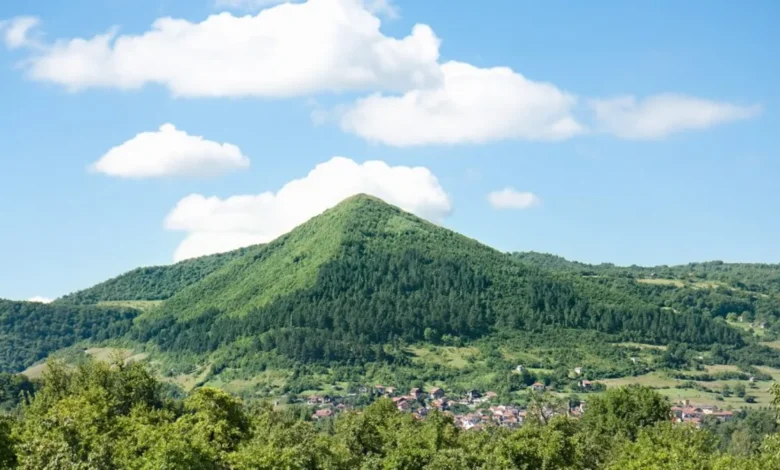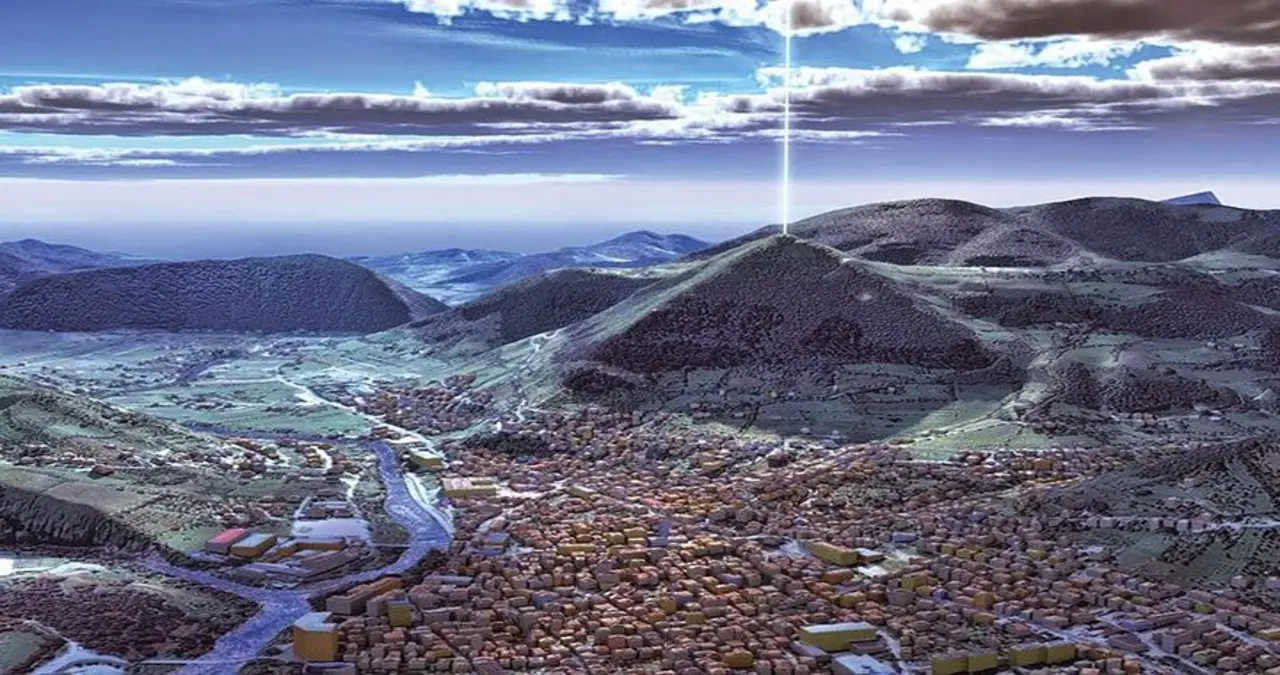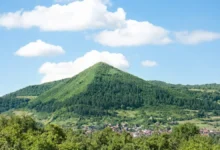Unveiling the Mystery of the Bosnia Pyramid

Bosnia Pyramid In the heart of the Balkans, nestled within the charming town of Visoko, a breathtaking mystery has captured the global imagination the Bosnia Pyramid. At first glance, it may seem like a mountain with a sharp triangular shape. But dig a little deeper, both literally and metaphorically, and you’ll find layers of curiosity, science, controversy, and sheer wonder. The Bosnia Pyramid has turned into one of the most hotly debated archaeological topics of the century. Is it a natural hill shaped by time and weather? Or is it truly the world’s oldest man-made pyramid?
Regardless of what side of the debate you’re on, the Bosnia Pyramid offers something remarkable — a story that brings together geology, archaeology, mystery, tourism, and a profound sense of discovery. Let’s dive into the enigmatic tale of this so-called pyramid and explore everything that makes it both fascinating and divisive.
The Discovery That Shook the Archaeological World
It all began when Bosnian-American author and entrepreneur Dr. Semir Osmanagić visited Visoko in the early 2000s. He noticed the remarkably symmetrical shape of a hill known as Visočica. Its sloped sides, sharp angles, and alignment with cardinal points struck him as odd. His initial thoughts led to a radical conclusion: this was not a hill at all, but rather a massive, ancient structure — the Bosnia Pyramid.
Dubbed the Pyramid of the Sun, this was just the beginning. Soon, Osmanagić and his team began identifying other pyramid-shaped hills nearby, which he later named the Pyramid of the Moon, Pyramid of the Dragon, and Pyramid of Love. Together, they formed what he referred to as the Bosnian Valley of the Pyramids.
The discovery exploded in the media, drawing international attention. While mainstream archaeologists expressed skepticism, the site became a magnet for alternative history enthusiasts, spiritual seekers, and curious travelers. The Bosnia Pyramid was no longer a quiet hill — it had become a global sensation.
What Makes the Bosnia Pyramid So Intriguing?
There’s no denying that the Bosnia Pyramid is a visual spectacle. Its four triangular faces seem too precise to be coincidental. The Pyramid of the Sun, in particular, rises over 220 meters, allegedly taller than Egypt’s Great Pyramid of Giza. And like Giza’s famed pyramid, the Bosnia Pyramid is also said to align perfectly with the true north.
Osmanagić’s team claims that beneath the surface lies a complex network of tunnels, blocks of ancient concrete, and even megalithic stones. Samples taken from these alleged concrete blocks were analyzed, with some reports suggesting that they exhibit strength and durability superior to modern concrete. This claim, if true, would place the Bosnia Pyramid among the greatest engineering marvels of the ancient world.
There are also reports of unusual energy readings. Some researchers claim that the pyramid emits electromagnetic radiation from its peak, while others speak of energy “beams” that defy known science. Visitors often report feelings of rejuvenation and heightened awareness, adding a mystical element to the story.
The Bosnia Pyramid is more than just a tourist attraction — it’s become a symbol of ancient knowledge, lost civilizations, and spiritual awakening for many.
Science, Skepticism, and the Battle for Credibility
Despite its allure, the Bosnia Pyramid remains one of the most controversial archaeological topics to date. Mainstream scientists and institutions, including the European Association of Archaeologists, have dismissed the claims as pseudoarchaeology. They argue that the hills are natural formations — the result of millions of years of geological activity — and that any rectangular stone found on-site is simply fractured sedimentary rock.
Yet the debate is far from settled. Supporters of the Bosnia Pyramid point to alternative findings, such as strange carvings, underground tunnels with dry stone walls, and even fossilized leaves embedded within large blocks, suggesting ancient construction techniques. They accuse mainstream academia of dismissiveness and arrogance.
The controversy doesn’t just lie in science but in the interpretation of evidence. Where some see nature, others see design. Where some see coincidence, others see a deliberate plan. And that’s the real power of the Bosnia Pyramid — it challenges how we think about history, evidence, and the line between discovery and speculation.
The Tunnel System Beneath the Bosnia Pyramid
One of the most fascinating aspects of the Bosnia Pyramid is the network of underground tunnels discovered in the region. Known as the Ravne Tunnels, these passages have become a central point of study and tourist exploration. The tunnels stretch for kilometers beneath the pyramid complex and are said to predate any known civilization in the area.
The tunnel walls are built using dry masonry, and the pathways show signs of intentional construction. There are also large ceramic blocks weighing several tons that have been uncovered in the tunnels. Some researchers believe these are energy amplifiers or conduits, part of a much larger energetic grid embedded within the pyramid complex.
Adding to the mystery, the air inside the tunnels has been described as “health-enhancing.” Measurements indicate extremely low levels of harmful radiation, high levels of negative ions, and a unique energetic resonance. Whether you’re a believer or not, standing inside these ancient tunnels stirs something primal — a deep curiosity about the hidden history of our world.
Global Reactions to the Bosnia Pyramid Discovery
The Bosnia Pyramid has drawn reactions from across the globe — some celebratory, others skeptical. Media coverage has ranged from supportive documentaries to scathing critiques. Major networks like National Geographic, BBC, and Discovery Channel have all covered the story, usually presenting it with a grain of scientific caution.
However, the attention hasn’t slowed the enthusiasm. Thousands of volunteers from all over the world have come to assist with excavation efforts. Conferences, books, and online forums have exploded with theories ranging from ancient aliens to lost Atlantean civilizations. For a hill in Bosnia to provoke this level of global discussion is nothing short of phenomenal.
Supporters often say that the Bosnia Pyramid has opened people’s minds to the idea that history may not be as straightforward as textbooks claim. It has become a modern myth-in-the-making, and whether it proves true or not, it has already made its mark on human curiosity.
The Spiritual Side of the Bosnia Pyramid
Beyond the science and skepticism lies another dimension — the spiritual one. Many visitors to the Bosnia Pyramid report transformative experiences. Meditation retreats are held near the site. Yoga practitioners, energy healers, and spiritual teachers from around the world have flocked to Visoko, calling it a place of high vibration and spiritual awakening.
Dr. Osmanagić himself has often linked the pyramid to ancient wisdom and universal energy. According to him, the structure is not just a physical artifact but also an energetic device — a tool for healing and consciousness elevation. This has led many to view the Bosnia Pyramid not only as an archaeological mystery but also as a modern spiritual pilgrimage site.
Even those without spiritual leanings often report a sense of peace and clarity after visiting. Whether it’s the mountain air, the scenery, or something more mysterious, the Bosnia Pyramid leaves an impression that’s hard to forget.
Tourism and Economic Impact in Visoko
The town of Visoko has seen a dramatic transformation since the Bosnia Pyramid was brought into the spotlight. Once a quiet town, it now welcomes thousands of tourists every year. Hotels, restaurants, souvenir shops, and tour companies have sprouted across the region, offering everything from guided tunnel tours to pyramid meditation experiences.
The Bosnia Pyramid has injected life into the local economy and helped put Bosnia and Herzegovina on the map for international tourism. Residents have embraced the interest, some even becoming guides, educators, or vendors for pyramid-related goods. It has become a rare case where science, myth, and economics meet to create a win-win situation for a community.
This tourism boom has also helped promote Bosnia’s rich culture, food, and natural beauty, expanding beyond the pyramid into nearby historical sites and landscapes. The Bosnia Pyramid has truly become the centerpiece of a growing cultural movement.
Comparing the Bosnia Pyramid to Other Ancient Structures
When discussing ancient megastructures, comparisons are inevitable. The Bosnia Pyramid is often compared to the Egyptian pyramids, Mesoamerican temples, and even megalithic sites like Stonehenge. Proponents argue that the Bosnia Pyramid is not only older but built with more advanced techniques than previously known to humankind.
Skeptics point out that no hieroglyphs, tombs, or burial artifacts have been discovered, which are usually key identifiers of pyramid cultures. Yet, in its unique way, the Bosnia Pyramid challenges those assumptions. It suggests that ancient peoples may have had different reasons for building perhaps more energetic or spiritual than ceremonial.
No matter how you frame the comparison, the Bosnia Pyramid stands out. Whether as a geological anomaly or an ancient wonder, it commands attention and invites dialogue on a global scale.

Quick Bio Table: Key Information on the Bosnia Pyramid
| Location Visoko | Bosnia and Herzegovina |
| Discovered By | Dr. Semir Osmanagić |
| Main Pyramid Name | Pyramid of the Sun |
| Claimed Height | Over 220 meters |
| Other Pyramids | Nearby Pyramid of the Moon, Pyramid of the Dragon, Pyramid of Love |
| Tunnels System Name | Ravne Tunnels |
| Key Features | Perfect geometric symmetry, underground tunnels, energy phenomena |
| Scientific | Controversy Widely disputed by mainstream archaeologists |
| Tourist Attraction | Yes, rapidly growing destination |
| Cultural Significance | Considered by some as a site of ancient wisdom and healing |
Frequently Asked Questions About the Bosnia Pyramid
What is the Bosnia Pyramid?
The Bosnia Pyramid is a large, pyramid-shaped hill in Visoko, Bosnia and Herzegovina, believed by some to be an ancient man-made structure. Others argue it’s a natural formation.
Who discovered the Bosnia Pyramid?
Dr. Semir Osmanagić, a Bosnian-American researcher, is credited with identifying the pyramid in the early 2000s.
Is the Bosnia Pyramid real?
That depends on how you define “real.” The hill exists, but whether it’s an artificial pyramid is still under debate between scientists and alternative historians.
Can you visit the Bosnia Pyramid?
Yes, it’s a popular tourist site with guided tours of the pyramid and the Ravne Tunnels.
Are the tunnels under the Bosnia Pyramid man-made?
Dr. Osmanagić and his team believe they are, while others argue they could be natural caves enhanced by humans.
Does the Bosnia Pyramid emit energy?
Some researchers claim energy beams and electromagnetic activity at the site, but these findings are not universally accepted.
What makes the Bosnia Pyramid different from the Egyptian pyramids?
Apart from its height and location, the Bosnia Pyramid allegedly aligns with energy sources and features a vast tunnel system not typical of Egyptian pyramids.
Why is there controversy around the Bosnia Pyramid?
Mainstream archaeology considers it a natural formation, while others believe it’s an ancient, man-made structure with advanced engineering.
Is there scientific proof that the Bosnia Pyramid is man-made?
No conclusive peer-reviewed studies have proven it is man-made, but alternative researchers cite various geological and structural features as evidence.
What is the spiritual significance of the Bosnia Pyramid?
Many believe it is a source of healing and energy, attracting spiritual seekers and meditation practitioners from around the world.







